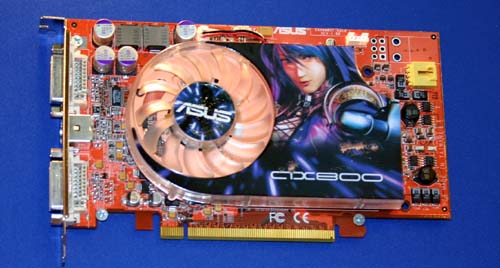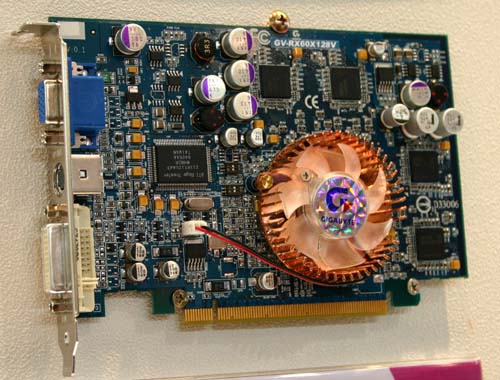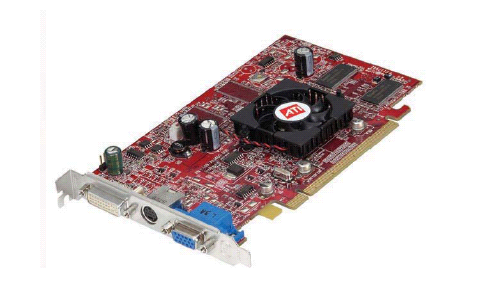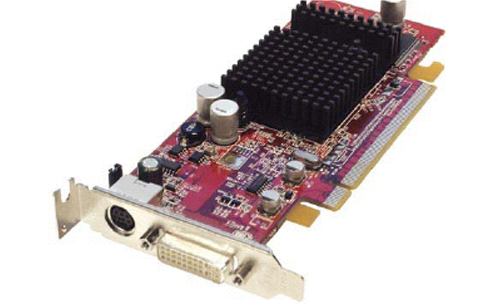
Original Link: https://www.anandtech.com/show/1336
New ATI Products Confirmed: The X Series Line-up
by Derek Wilson on June 1, 2004 6:00 AM EST- Posted in
- GPUs
Introduction
Today, ATI is announcing quite a few new products. Unfortunately, we don't have any numbers to bring to the table today, but there are some very interesting developments in both desktop and mobile. Much of what we see finalized today had been rumored for a while, so this article is more of a confirmation of those suspicions and a summary of what we can expect to see coming to the market from ATI.Some of the details won't be known until closer to product availability, but most of the information is fairly straight forward. ATI is introducing three new desktop parts and one new mobile part. In addition to their new GPUs, they are announcing the introduction of a reference design for a modular PCI Express graphics platform.
The most exciting news that we have is about the low end and mobile Radeon X-series parts. The new high end desktop series that ATI is releasing will be the R423 based PCI Express Radeon X800 line, and the new mid-range cards will be RV380 (which is basically a PCI Express version of RV360 and the 9600).
Before we get to the table listing all the specifications for each new ATI part that is launched today, let's take a closer look at the newest kids on the block.
X800 PCI Express and X600
The only difference that we know about between R420 and R423 at this point is in the bus interface, but it is still possible that ATI will decide to increase the stock clock speed for their PCI Express parts to offer a little more incentive for enthusiasts to upgrade their systems. We do expect to see a Pro and an XT part much the same as the AGP line of cards.
There will be two flavors of the X600 (Pro and XT), and this time around, the X600 Pro will be a PCI Express version of the 9600 Pro with 400MHz core and 300MHz (600MHz data rate) memory clocks. The X600 XT increases the memory speed to a 740MHz data rate, but the core clock remains the same at 500MHz. As such, we shouldn't expect to see much of a performance boost over current 9600 parts. This part is being marketed as the "world's first native PCI Express graphics card", but we'll have to wait for performance numbers to see if that really means anything.

Really, there isn't too much to say about these parts, since the only real difference is the bus interface. Of course, that doesn't mean that we don't have anything interesting to talk about, such as ATI's angle of attack on smaller fab processes.
X300 Debuts at 110nm

The PCI Express Radeon X300
In the same way that ATI moved into the 130nm low-k process with the 9600 line of cards, the RV370 GPU of the X300 will be fabbed on a 110nm process. As usual, TSMC is behind the silicon process that ATI is using.
It's good to see ATI sticking with a strategy that has worked for them. Taking an aggressive chance on one line of mid-range or low end GPUs before moving the rest of the parts to another process is a very good way to work out the kinks without incurring too much risk. In the worst case scenario, ATI could have covered the market segment with a lower clocked or otherwise handicapped version of a higher performing part while fixing what went wrong. What we have seen in the past with NVIDIA and large CPU vendors has consisted of large scale shifts in process technology, which can really hurt production and/or time to market if something goes wrong.
Among the benefits that ATI cites in TSMC's 110nm process is the ability to fit 40% more transistors in the same area as 130nm. A straight die shrink only accounts for about a 30% increase in space efficiency (1 - 1102 / 1302), so it stands to reason that TSMC must have made up the space savings in other areas of their process technology. Either way, this means that ATI has a lot of headroom with what they want to do with RV370.
Of course, with any new process, yeilds will be lower than what would be desired for the same performance level on an established process. Our theory is that ATI has worked out a way around this issue by taking the RV360 (Radeon 9600) core with a few tweaks, and fabbed it on a 110nm process, and dropped the clock speed way down in order to achieve acceptable yeilds. We can't be sure about this, as ATI isn't going to share yield rates or if this is actually a reason why they have taken this route. The pieces just seem to fit together too well, but it's still possible that it's all just coincidence.
The RV370 GPU will eventually be marketed as two parts: the Radeon X300 and the Radeon X300 SE. The SE part will have a cut-down 64bit memory interface similar to the 9200 SE. This value segment part will perform better than the 9200 SE part both because its based on the RV360 core, and its a higher clocked part. Hopefully, this also means that the compatibility issues we saw with the 9200 parts will fade into the distance as well. The regular X300 will have a 128bit memory interface.

This is the half-size btx version of the X300se.
We haven't seen any of these parts yet, but if we stumble across any on the show floor at Computex, we'll be sure to include pictures.
Now, on to the mobile arena.
Mobility Radeon X600
The Mobility Radeon X600 looks to be (oddly enough) a mobile version of the X600 with certain enhancements. We're looking at a 130nm low-k process with a 128bit memory interface, 2 vertex pipes and 4 pixel pipes. The extra enhancements that ATI has made to the GPU include a new revision of Powerstep (5.0), and something that ATI is calling "LCD-EE".Powerstep 5.0 includes an exciting feature called "VARI-BRIGHT". This technology is the same as something that we saw at last fall's IDF from Intel. The idea is to control adaptively the brightness of the LCD's back light based on what is happening on the screen. The power required to keep an LCD panel lit up for extended periods of time can really eat into battery life, and if ATI and Intel can include adaptive backlight control on their mobile graphics parts, then we could see some pretty decent leaps in effective battery life for notebooks.
I've also been asking around to see whether or not this could help make blacks blacker on LCD displays; even when an LCD pixel is "off", some of the light from the backlight bleeds through. If both the backlight behind a pixel and the pixel itself are off, could this help? No one seems to know the answer, but I'm sure that we'll end up seeing what happens when this technology rolls off the shelf.
The other interesting thing about ATI's upcoming mobile part is LCD-EE. This block of the GPU includes resolution scaling for laptops and support for new high resolution widescreen panel support. But the feature that we are most interested in learning more about is LRTC (LCD Response Time Compensation). The idea behind the technology is to match the timing of a video overlay better with the response time of the LCD panel. This should, in theory, keep pixels from being drawn faster than they can switch, thus avoiding blurriness issues.
We don't know enough about LRTC technology to know how it works or whether or not it will be really useful to the end users, but we are hoping to learn more from ATI as soon as possible. The technology has potential, but we'll need to learn a little more about it and see it in action before we write home about it.
Modular Mobile Technology
ATI is also following suit with NVIDIA and launching a modular PCI Express reference design for notebook OEMs and ODMs. The ATI solution is called "AXIOM", and unlike NVIDIA's MXM module specification, AXIOM does not use a modified SODIMM or other perpendicular connector. Instead, the connector is on the bottom of the module, so there will be a little bit of space between the motherboard and the module (which ATI says will be useable motherboard space).Unlike MXM, ATI isn't pushing for an across-the-board standard, but rather a reference design that manufacturers can pick up and run with in order to shorten time to market. Really, this is the ultimate goal of NVIDIA's MXM as well, but NVIDIA's take on the issue is that the more standard things become, the easier things will be down the road.
Both the AXIOM module and the MXM module can be used with either NVIDIA or ATI GPUs, but ATI is also pushing the idea that AXIOM can be used for different types of PCI Express devices in notebooks. For this to be feasible, there would have to be multiple sized connectors for x1 and x4 PCI Express interfaces (the full x16 interface would just waste space for devices other than graphics), but we haven't seen any of the specs for these connectors yet.
In the end, we feel that modular parts for notebooks will really help the mobile market keep pace with the lastest technology, while allowing for the future possibility of user upgradeable modules as well. If a real standard is to come into play in the future for notebooks, it will need to be a standard agreed upon by all the key players in the industry. Essentially, a Standards body, like the PCI SIG, will have to put some work into the issue. From what we have heard, both ATI and NVIDIA are not opposed to working with a Standards body on modular PCI Express graphics, but both also have their reasons for not having done so yet.
Hopefully, both of these technologies can work together to help motherboard makers get mobile graphics parts out as fast as possible.
Final Words
Even though we don't have parts in our hands yet, we are excited to test out the new 110nm parts, as well as the new mobile technology coming down the pipe this year.To sum up, click on the following link to the table that shows what ATI is announcing today, and the specs for everything.
ATI Card Table
Of course, after this first round of PCI Express graphics card releases, ATI will be slowly moving its new R4xx style architecture down through the mid-range and low end as well. It remains to be seen how NVIDIA is going to handle the mainstream market segments, but ATI is only bringing a few new enhancements to their current lineup of graphics cards today. Among the new include PCI Express support, a 110nm fab process for the X300 (which we assume to be based on the 9600 core due to its RV370 model number), and a couple of new power-saving and image quality enhancing technologies that will come to the mobile market whenever the Mobility Radeon X600 finally makes its way into a notebook near you.







